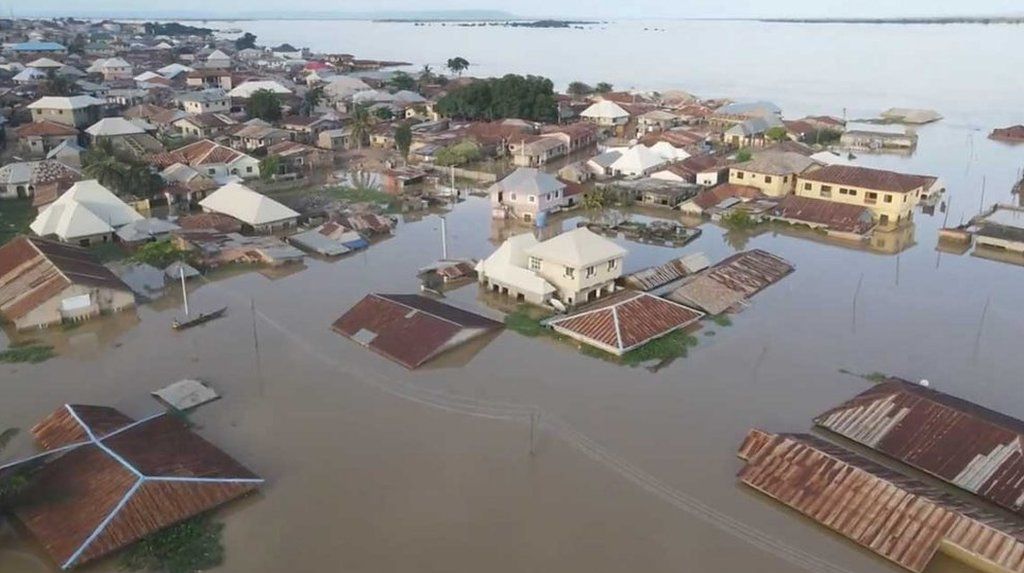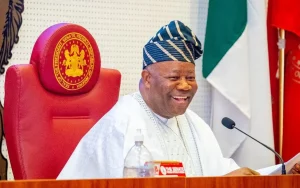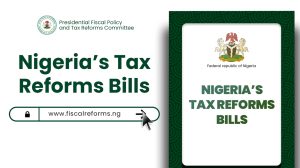Flood Funds: Despite Getting N7.3b Ecological Fund, 12 States With Flood Hotspots Used Only N3.6b for Environmental Projects
On Thursday, the National Emergency Management Agency (NEMA) issued a safety advisory urging residents across 27 states to relocate.
These warnings were not arbitrary; the agency had analysed some communities and determined they faced a high risk of severe flooding. And flooding never leaves anything positive in its wake.
Such advisories are not uncommon in Nigeria. In fact, it’s almost a yearly ritual for the Nigerian Meteorological Agency (NiMet), the Nigeria Hydrological Services Agency (NIHSA), or even the Federal Ministry of Water Resources to issue statements preparing states for environmental emergencies such as heavy rainfall and flash floods during certain months of the year.
Just this April, the Ministry of Water Resources warned that 31 Nigerian states were at risk of severe flooding in 2024. These projections are rarely wrong. In July alone, heavy flooding claimed 15 lives and displaced around 16,000 people, according to a report by Daily Post.
It’s not as though Nigeria stands idle while floods ravage its communities. Alongside state-level efforts, the Federal Government allocates funds to each state monthly to address various ecological challenges across the country.
This allocation, known as the Ecological Fund, is derived from 2.3% of the Federation Account. These funds are distributed to states based on the severity of their environmental challenges.
However, an analysis by PulseNets has uncovered discrepancies between the amounts allocated to states and the actual expenditures on environmental protection projects from January to June.
While some states have shown positive budget performance, 12 out of the 36 states have spent less than the amount they have got on ecological projects or projects of enviromental importance.
PulseNets reached this conclusion by comparing the budget performance of these states up to the end of the second quarter of 2024 with the amount they received from the Ecological Fund during the same period.
VERY LOW PERFORMERS
Eight states performed particularly poorly — spending below 50% of their Ecological Fund allocations — on environmental protection in the first half of the year. These states are Adamawa, Ebonyi, Anambra, Bauchi, Benue, Enugu, Zamfara and Kebbi.
For instance, Anambra received over N654 million in federal allocations as part of the Ecological Fund between January and June but spent a meager N56 million on environmental projects during the same period. This N56 million covered salaries, overhead costs and capital projects.
To put this in context, no fewer than 46 households in Adamawa were directly affected by flooding between January and July, according to available data. Another 2,608 households in the state are considered highly susceptible to severe flooding.
Similarly, Anambra’s expenditure on environmental protection mirrored Adamawa’s low figures. Despite Adamawa receiving over N653 million from the Ecological Fund, the state spent only about N56 million on environmental protection or ecological projects. This expenditure included personnel, overhead costs and capital projects.
Although flood data for the state is limited, both NEMA, NIHSA and the Ministry of Water Resources have flagged Anambra as highly vulnerable to severe flooding. In July, the Punch Newspaper reported that heavy flooding swept away four people in the state.
| STATES | ECOLOGICAL FUND ALLOCATION (JAN-JUNE) | AMOUNT SPENT ON ENV/ECOLOGICAL PROJECTS (JAN-JUNE) |
| Adamawa | 654,518,043.89 | 56,029,706.76 |
| Bauchi | 785,932,021.17 | 383,316,165.55 |
| Anambra | 653,291,881.39 | 56,420,932.39 |
| Zamfara | 653,842,435.01 | 319,970,940.8 |
| Benue | 368,431,037.83 | 49,665,954.25 |
| Enugu | 660,770,112.34 | 99,465,318.05 |
| Kebbi | 346,895,404.4 | 153,469,027.02 |
| Ebonyi | 587,821,265.02 | 274,999,015.93 |
In Benue, just N49 million was spent on environmental protection and ecological projects between January and June, even though the state receiving more than N368 million from the Federal Government during the same period.
By June, nine out of the 23 local governments in Benue were projected to experience severe flooding, according to both the state emergency management agency and NEMA.
Enugu received over N660 million from the Federal Government between January and June but allocated just over N99 million to environmental protection during those six months.
Kebbi, which received about N346 million for ecological projects between January and June, spent only around N153 million on such projects. In August alone, flood disasters affected at least 13 local governments, with 300 people and 200 households impacted, according to reports.
Ebonyi, which has limited flooding reports but is listed as a flood-prone zone, received over N587 million from the Federal Government in the first six months of the year. However, the state spent only N274 million on environmental protection during the same period.
Early August, a heavy downpour destroyed at least 2,000 homes in Zamfara, according to community sources. In July, NEMA had identified eight local government areas as highly susceptible to flooding.
But, despite receiving over N653 million from the Federal Government between January and June, Zamfara spent only about N319 million on environmental protection projects during that period.
Finally, Bauchi received over N780 million in Ecological Funds between January and June but spent just N383 million on environmental protection in that period. On Tuesday, a massive flooding disaster in Bauchi destroyed more than 1,000 houses and claimed three lives, according to a Channels TV report.
BARELY AVERAGE PERFORMERS
Four additional states — Borno, Cross River, Ebonyi, Jigawa, Sokoto, and Zamfara — managed to spend more than 50% of their Ecological Fund allocations from the Federal Government.
But this level of spending remains inadequate against these ecological crises claiming Nigerian homes and lives. After all, the states still fell short of fully using the funds despite cases of severe flooding and other environmental crises.
In Borno, over N816 million was allocated in ecological funds between January and June. Yet, only about N770 million was spent on environmental projects in that time frame.
| STATES | ECOLOGICAL FUND ALLOCATION (JAN-JUNE) | AMOUNT SPENT ON ENV/ECOLOGICAL PROJECTS (JAN-JUNE) |
| Borno | 816,337,577.17 | 770,053,857.68 |
| Cross River | 330,356,544.18 | 314,286,644.43 |
| Jigawa | 734,779,377.86 | 651,006,915.19 |
| Sokoto | 724,123,071.8 | 494,369,624.89 |
| Zamfara | 653,842,435.01 | 319,970,940.8 |
Despite this, the impact of flooding and windstorms was devastating. At least 20,000 households were ravaged between January and July.
Another 162,571 households risk displacement in the same state. On August 6, severe flooding struck three locations, displacing around 2,800 people and damaging 243 shelters, according to the International Organisation for Migration’s displacement matrix.
Jigawa has arguably endured the harshest flooding related crises in 2024. On a single day in August, 16 lives were lost, and 3,936 houses were destroyed due to flooding, according to the state’s emergency management agency.
But despite receiving N734 million from the Federal Government during the first half of the year, the state utilised only N655 million for environmental protection in the same time frame.
In Sokoto, severe flooding displaced 1,664 people in just one local government area as recently as July. The Federal Government had allocated about N724 million to Sokoto for ecological challenges between January and June.
However, only N494 million was spent on environmental protection in the same period. This includes the costs of staff salaries and related overheads.
DECENT PERFORMERS AND FISCALLY OPAQUE STATES
Some states did fairly well with the Ecological Fund they received from the Federal Government. But when it comes to actual budget performance, all 32 states PulseNets analysed fell short.
Even top performers like Katsina, which received about N807 million but spent around N16 billion, only managed to achieve 43% of its budget in the first half of the year.
Niger, which received about N389 million and spent around N2.3 billion, completed only 39% of its budget in the same period. Lagos, which spent the most at N35 billion after receiving about N880 million, still only hit 43% of its budget for the first half of 2024.
Detailed comparisons of environmental protection expenditure against Federal Government ecological allocations between January and June are included in this spreadsheet and document.
PulseNets couldn’t get budget performance data for states like Kaduna, Oyo, Rivers and Taraba for various reasons. In Rivers and Kaduna, the problem is a lack of transparency.
Normally, states are supposed to prepare quarterly budget reports and release them within four weeks from the end of every quarter. This is required by the fiscal responsibility laws of both Rivers (2010) and Kaduna (2016).
In Rivers, the most recent budget report was from the fourth quarter of 2023 at press time. Kaduna published its report for the first quarter of 2024 in June, long after the quarter ended, and the report for the second quarter is missing.
Oyo and Taraba have a different issue. Despite the mandate from the National Information Technology Agency, their websites are simply inaccessible. While searches showed that they had published budget reports for the second quarter, the reports were not accessible to those who needed it.
ECOLOGICAL FUND USAGE HAS ALWAYS BEEN CONTROVERSIAL
Sometime in 2016, there was a demand for the Federal Government to release ecological funds to states.
Abdulaziz Yari, who led the Nigeria Governors’ Forum at the time, pushed for this, citing severe environmental issues across different regions. The demand made headlines and generated controversy.
“We are seriously concerned about the environment. The North is dealing with desertification, the South-South with oil spills, and the South-East with erosion. We need these funds every month because they are federation funds, and we have many problems to address. We need the money,” Yari said, according to Premium Times.
By 2022, the situation had changed. It was the FG’s turn to call out the state governments for misuing the fund. Mohammed Abdullahi, the Minister of Environment at the time, demanded solutions for environmental challenges from their governors. He specifically accused the governors of misusing the ecological funds allocated to them.
That same year, lawmakers started investigating how state governors had spent these funds. The investigation also included Federal Government ministries, departments and agencies involved in managing the funds.
Also Read: Flood: Urgent repair for Affected roads demanded by Bauchi Assembly
More recently in 2023, Shehu Ibrahim, the Permanent Secretary of the Ecological Fund Office, called state governments out over the structures to manage the funds.
During a session with lawmakers, he mentioned that states did not allow his office to monitor how the funds were used, despite the absence of proper management systems.
Despite these issues, PulseNets found no reports of thorough audits on how these funds were used. No state governor has faced charges for mismanaging ecological funds.
Beyond the loss of lives and private properties, reactionary environmental protection costs Nigeria billions in public infrastructure.
PulseNets recently reported how the Kano-Maiduguri Highway was destroyed by flood, only three years after the Federal Government spent N51.99 billion to build it.
First published by FIJ













